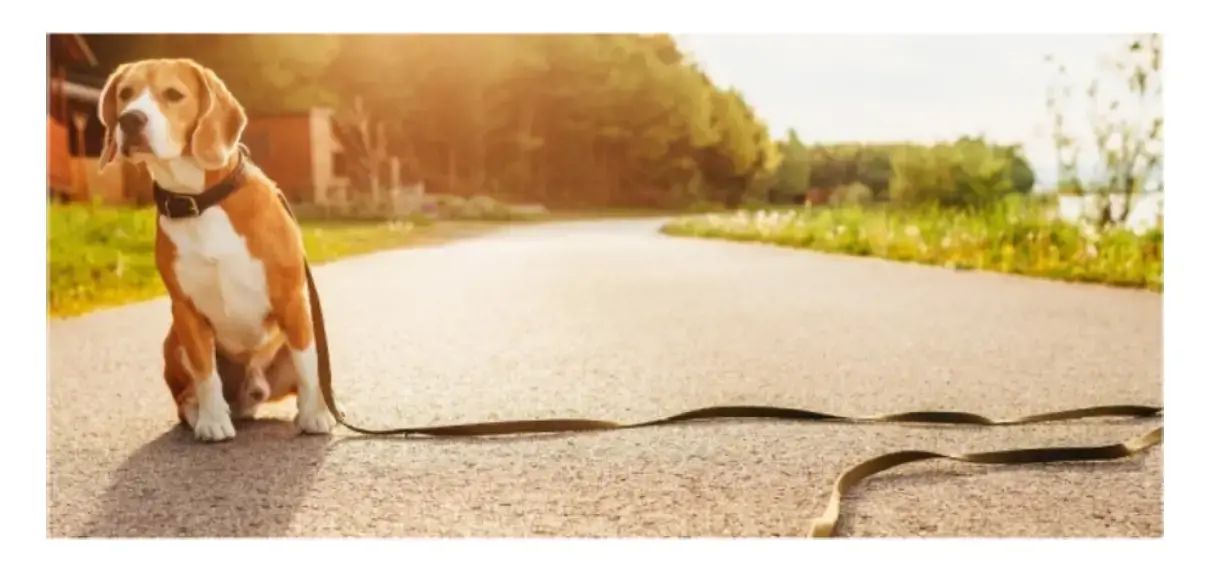What to do if you find a lost dog UK
25th March, 2024

Lost & Found: A guide for if your pup goes astray
If the dog is in imminent danger or in a dangerous location, contact emergency services. Never put yourself in danger.
Remember the dog may not be a stray at all but a dog that has wandered away from their owner.
Follow these steps instead to help reunite the dog with their owner
- Check to see if the dog is wearing a collar or tag with the contact details of the owner.
- Only approach if the dog is calm.
- Stay clear if the dog is displaying aggressive behaviour and contact the local dog warden.
- Report the stray dog to the council. All local authorities provide a dog warden service.
- Contact the local vet to scan for a microchip, as all dogs by law should be microchipped.
- Contact local animal shelters and report the found dog
- Use social media to check local groups and announce you’ve found a dog. Spread the word locally.
I’ve lost my cat, what should I do?
A missing cat means a great deal of worry and heartache.
You may have recently moved: many kitties become anxious and run away when uprooted, forgetting their way back to your new home.
Your cat may have been injured or faced a medical complication.
Take a look at our comprehensive guide for what to do here.
How do you deal with stray dogs?
Coming across a stray animal can be upsetting, especially if it has been injured in any way.
Your first instinct may be to help, but there are some things to consider first before you head into action:
Is it safe to approach the animal?
- Animals can be aggressive if they’re in pain, especially lost or frightened pets
- Are you putting yourself in danger? If the animal is in a dangerous situation like they’ve fallen into water or they’re stuck in a hole, going after them could put your life in danger too.
- Call for help. If in doubt, it’s best to call for professional help. The RSPCA has a 24-hour helpline (0300 1234 999).
Be cautious when approaching unknown dogs, as you never know how they’ll react to a strange person.
Always take it slowly. Dog bites can be serious so put your own safety first.
If the dog is friendly, approachable and seems healthy, try to get them to a local dog warden, vet, or rescue centre.
They can then be scanned for a microchip, for which you won’t be charged.
It’s the law that all dogs must be microchipped, so this is the best way of reuniting them with their owner.
If the dog isn’t microchipped or you can’t catch it, posting photos on local social media groups or lost and found pet sites can also help to reunite a lost dog with its family.
If the dog is aggressive in any way, then keep your distance.
Call the local dog warden and give them as much information as possible.
If the dog is injured, be cautious when approaching. If a dog is in a lot of pain and frightened, they may act aggressively to you.
In this case, don’t attempt to move the dog on your own and get professional help. This may be an RSPCA inspector or dog warden, vet or vet nurse that are able to come out to the scene.
If the dog is not showing signs of aggression and is calm with your approach, transporting the dog by wrapping it in a blanket or towel will help.
This will be a first step in offering first aid and by keeping the dog warm to prevent shock, the blanket will be more comfortable for the dog and then you can then take them to your nearest vet.
What to do if you have lost a dog?
Losing your beloved dog can be incredibly scary.
Here are some top tips for being reunited with your pooch as soon as possible:
- Contact your local authority dog warden. The dog or animal warden for your local council is legally responsible for stray dogs and is most likely to have picked them up if they have been found wondering the street. Make sure you contact your surrounding local authority areas too, as dogs can travel quite a long way. The council must legally hold on to a stray dog for 7 days (5 in Northern Ireland) before they can rehome them, pass them to a rehoming organisation, or have them humanely put to sleep.
- Contact local kennels, rehoming centres, and vets. If a member of the public has found your dog, it’s possible that they’ve been handed into their local kennels, council, or vets. If your dog is a pedigree, try local breeders. Contact the Kennel Club on 0870 6066750 for details of your local breed rescue group. Contact all the vet practices in your area, and ask them if you can put a lost dog poster up in their surgery with details to contact you if your dog is brought in.
- Contact your microchip database and DogLost. Contact your microchip database to tell them that your dog is lost. They can notify you if someone tries to change your dog’s chip details. It is also important that you notify the database to let them know if your dog is found. Ensure you register your dog as lost on the DogLost site.
- Notice boards, registers, and social media. Ask your local supermarket, shops, libraries, newsagents if you can put a lost dog poster on their noticeboard. Contact local dog walkers in your area. Ask them to keep an eye out for your dog, and to contact you if they spot them. Social media is free and can be amazingly effective. Post clear photos, descriptions and your contact details to Facebook, Twitter, Instagram, etc. so that your friends and followers can join the search. There are Facebook groups devoted to helping lost dogs be reunited with their owners, so be sure to post in those and search for any found dogs that could be yours.
- Local areas and buildings. Visit places where you usually walk your dog. They may have just decided to walk themselves and could be sticking to familiar places. If you have moved house recently, ask around at your previous address, and inform your neighbours how to contact you if they spot your dog. If there are any building sites or workers in your area, ask around in case your dog has become trapped somewhere on site. If you think your dog has been stolen, call the police.
Can a dog find its way home if lost?
A lost dog can find its way home, but odds are they'll be picked up by a rescuer first. People are more likely to intervene because it's less common to see a roaming dog than to come across a community or outdoor cat. Lost Pet Research & Recovery indicates that 93% of lost dogs are found alive, and 20% of them return home on their own.
Can a lost dog be tracked?
Micro-chipping your dog can’t provide you with real-time tracking, but it can help you reunite with your furry friend if they go missing, something deeply valued by pet owners.
There are several other alternatives that you can use to track a lost dog, and which differ from the microchip technology. They include:
- GPS Trackers. A GPS tracking device is one of the most efficient tools and the fastest way to track a lost pet. As long as the GPS tracker is on the dog, you can get real-time location and reading. Although GPS tracking devices can be expensive, they are totally worth the investment. A GPS tracking device usually comes pre-inserted in a dog’s collar. You can also insert it into the pet’s current collar, which is also very convenient. Most GPS trackers use batteries, so don’t forget to change the battery when it’s low.
- Cameras. You can also use hidden cameras around your home to track a lost pet within your immediate surroundings. With home security cameras, the pet owner can see the dog’s movements around the house, yard, and, depending on the coverage, the immediate surroundings. The footage can give insight into how the pet left home, likely areas to look for, and the next step.
- Motion Detector. It is possible to track a pet from a distance with a small device called a motion detector. This detects movement above a certain level and sounds an alarm. It is handy in large and busy areas where many pets are walking around.
What Are the Chances of Finding My Lost Dog?
Within the first 24 hours of your dog being marked as “lost,” the chances of finding them are as high as 93%.
After that 24-hour mark, however, the chance of finding your dog drops to 60%.
However, not all who wander are lost; some animals are found close to home, on average, just a few houses away.
They may have gotten out of their yard and decided to follow a smell to the neighbour’s house, but they're still in the vicinity of where they started.
Before removing a found dog or cat from their environment, knock on doors, and see if anyone recognizes the pet.
You might meet a surprised pet parent who had no idea their best buddy had gotten out.
Helpful Pages
Recent Posts

Why do Great Danes bury their heads?
12/03/25
Find out more about Beagles
28/02/25
How much chocolate can a dog eat?
28/02/25Pet Insurance Quote
- 98% claims paid *
- Claims paid directly to vets
- 24/7 vet video consultations
- Interest free monthly payments

